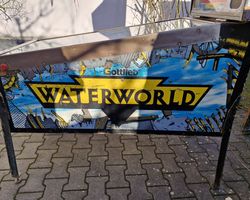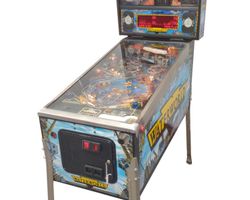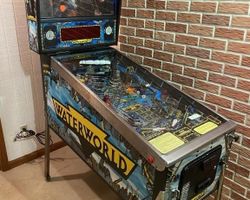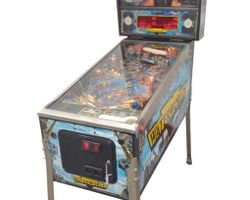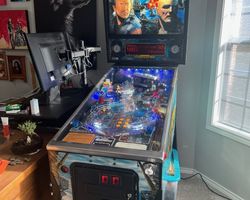Waterworld
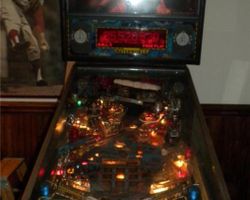
Average Prices: USD $600 to $2,000
Produced: October, 1995
Production Run: 1,500 units
Machine Type: Solid State Electronic
MPU: Gottlieb System 3
Players: 4
Design by: Ray Tanzer, Jon Norris
Art by: Constantino Mitchell, Scott Melchionda
Dots/Animation by: Scott Melchionda, Alycen Hareas, Vecennia Jordan, Rand Paulin
Music by: Duane Decker
Sound by: Craig Beierwaltes
Based on the divisive cinematic production of the same name, the Waterworld pinball machine was manufactured by D. Gottlieb & Co. and released in August 1995, under their pinball division, Premier Technology. This solid-state electronic (SS) machine was one of the last titles produced by the company, leveraging the robust Gottlieb System 3 MPU. With a production run of 1,500 units, Waterworld emerged during a period of intense competition within the pinball industry, aiming to capture the attention of a market increasingly drawn to licensed themes.
The development of Waterworld involved a dedicated team bringing the post-apocalyptic, ocean-faring world to the pinball playfield. Design responsibilities fell to Jon Norris and Ray Tanzer, who crafted the game’s layout and core mechanics. The visual aesthetic was shaped by artists Constantino Mitchell and Jeanine Mitchell, tasked with translating the film's gritty, waterlogged future into pinball art. Duane Decker composed the musical score, while Craig Beierwaltes handled sound design, including custom speech. The animations for the Dot Matrix Display were created by Alycen Hareas, Rand Paulin, Scott Melchionda, and Vecennia Jordan. The challenge for the team was to create an engaging pinball experience despite the lukewarm reception of its source material, a factor that would ultimately influence the machine's initial market perception.
Signature Features and Design
Waterworld distinguishes itself with several unique playfield elements, designed to immerse players in its aquatic, wasteland theme. The standout feature is the "Half-Pipe Ramp," a prominent shot that curves into a suspended motorized boat. This boat, often referred to as the "Valdez ship" or "Atoll," is central to the game's mechanics, rotating to capture and release balls. Its movement and integration with the primary ramp create a kinetic focal point on the playfield, enhancing the visual spectacle and providing a distinct objective.
Another notable visual feature is the "Jet-Ski Toy" positioned on the right orbit. While not directly interactive with the ball, this toy raises up on certain shots, serving as a dynamic piece of theatrical flair that reinforces the movie’s theme. The game also incorporates a "Swinging Ramp," which adds a layer of shot variety and challenge. The artwork, by Constantino and Jeanine Mitchell, endeavors to capture the film's bleak, water-logged aesthetic, depicting key characters and scenes from the cinematic narrative. This artistic interpretation, combined with custom speech callouts featuring character voices from the film, including memorable lines, works to deepen player immersion within the game's unique environment.
Playfield and Mechanics
The playfield layout of Waterworld is designed around a central half-pipe ramp that feeds directly into the motorized boat mechanism, dominating the upper playfield. This ramp is a primary shot for progression, used to spell "WATERWORLD" and advance game modes. Below this central feature, the two flippers are positioned slightly higher than is typical, influencing ball control and shot geometry.
Major shots include the Left and Right Orbits, which circle the upper playfield. The left orbit features a diverter, directing balls to different areas based on game state. A challenging "Harpoon Lane" is located on the left side, notoriously difficult to hit directly but offering significant rewards. Complementing this is the "Curvy Lane" on the right, which can feed the Harpoon Lane, creating combo opportunities. The playfield also features two drop targets and three traditional bumpers strategically placed to add chaos and point scoring opportunities.
A hexagonal "Dive Hole" serves as a crucial sinkhole, offering a variety of awards from a grid system. This shot provides strategic depth, as players must choose or unlock specific awards. The overall artwork on the playfield aims to convey the scarcity and desolation of the movie’s setting, with muted tones and detailed illustrations of the various water vehicles and structures. However, some players have noted that the playfield lighting can be suboptimal, occasionally making certain areas appear darker than ideal, which can impact visibility during fast-paced play. The layout, while containing unique elements, prioritizes repeatable ramp and orbit shots, forming the backbone of the game's flow.
Gameplay Dynamics
Waterworld presents a gameplay experience centered around navigating the perils of a submerged future, featuring a progression system built on unique objectives and a distinct scoring mechanic. The primary scoring innovation is the "Dirt as Currency" system, where players collect "Dirt" throughout the game by hitting various targets and completing objectives. These "Dirt" units can then be exchanged for specific awards and bonuses, with the trade values clearly listed on the bottom arch of the playfield. This mechanic adds a strategic layer, prompting players to decide whether to save their Dirt for larger rewards or spend it incrementally.
The machine’s main objective culminates in a four-ball multiball, initiated by locking three balls in the rotating boat. Once the balls are locked, the boat turns to release them for the start of multiball, which uniquely requires a manual plunger for each ball launch. Beyond multiball, players progress through the game by spelling "WATERWORLD" via repeated shots up the half-pipe ramp. Completing this spelling sequence can unlock new opportunities and increase scoring potential.
The "Dive Hole" is integral to progression, as hitting this hexagonal sinkhole awards one of nine different prizes arranged in a grid. These awards can range from extra balls and bonus multipliers to "Feature" awards, which often allow players to choose a desired bonus, such as a "Super Hint" to guide their next move. Lighting a complete line or corners on this award grid can activate additional modes and unlock higher-value targets. While the game features traditional combo and jackpot opportunities, the unique "Dirt as Currency" system and the strategic Dive Hole awards distinguish its scoring and progression from many contemporary machines. Despite some feedback suggesting potential shot repetitiveness, the varied ruleset provides a deeper experience for players who invest time in understanding its intricate mechanics.
Reception and Legacy
Waterworld has garnered a mixed but largely positive reception within the pinball community, often described as an underrated machine. Its connection to a cinematically maligned film initially cast a shadow over the pinball adaptation, but players who gave the machine a chance frequently discovered a surprisingly engaging experience.
Among its strengths, players often cite the machine's unique features. The rotating ship, the swinging ramp, and the aesthetic jet-ski toy are frequently highlighted as inventive mechanical elements that contribute to the game's distinct identity. Many enthusiasts praise the rule set as being varied and deep, especially once its nuances are understood, providing a rewarding progression for dedicated players. The game is often described as fun, fast-paced, and capable of providing stress relief. Dennis Hopper's custom callouts are commonly mentioned as a positive, adding character and humor to the gameplay. Furthermore, the Gottlieb System 3 platform on which Waterworld was built is recognized for its reliability, a factor that contributes to the machine's appeal as a durable and functional collectible. For its features and depth, Waterworld is also often considered a good value compared to other dot matrix display (DMD) games from its era, making it an accessible entry point for collectors or a solid addition for parties.
However, the machine is not without its criticisms. The artwork on both the playfield and backglass often receives negative feedback, with some finding it uninspired or poorly executed, failing to fully capture the potential of the theme. The inherent negative reputation of the Waterworld movie also posed a challenge, influencing initial perceptions. Some players have found the gameplay to be clunky or repetitive, suggesting that the rules can become stale more quickly for certain playstyles. Concerns about playfield lighting making the surface appear dark, coupled with sound and music that some describe as generic or grating, are also noted drawbacks. Despite these points of contention, the overall sentiment remains that Waterworld is a machine that often surpasses expectations, proving to be a "sleeper hit" that is better than its initial reputation might suggest. Its unique features and gameplay depth have earned it a loyal following, cementing its place as a machine of considerable interest for those seeking something beyond the more common pinball titles.
Sponsored Links
 Ebay Listings
Ebay Listings
 Auction Results
Auction Results
| Cost | Location | Date |
|---|---|---|
| USD $3,500 |  Florida, United States Florida, United States |
28 October, 2025 |
| EUR €1,800 |  Hessen, Germany Hessen, Germany |
06 July, 2025 |
| USD $5,999 |  California, United States California, United States |
10 December, 2023 |
| USD $2,000 |  Maryland, United States Maryland, United States |
07 December, 2023 |
| USD $2,300 |  Maryland, United States Maryland, United States |
07 October, 2023 |
| USD $2,300 |  Maryland, United States Maryland, United States |
07 October, 2023 |
| USD $3,500 |  Oregon, United States Oregon, United States |
28 August, 2023 |
| USD $3,200 |  Indiana, United States Indiana, United States |
27 August, 2023 |
| USD $2,999 |  Florida, United States Florida, United States |
03 May, 2023 |
| USD $3,000 |  Ohio, United States Ohio, United States |
28 February, 2023 |


Private Policy · Search Website · Contact Us
As an eBay Partner, we may earn a commission from qualifying purchases made through links on this site, at no additional cost to you.
All trademarks and copyrighted materials remain property of their respective owners. All other content copyright 2007 - 2025 Pinpedia.

